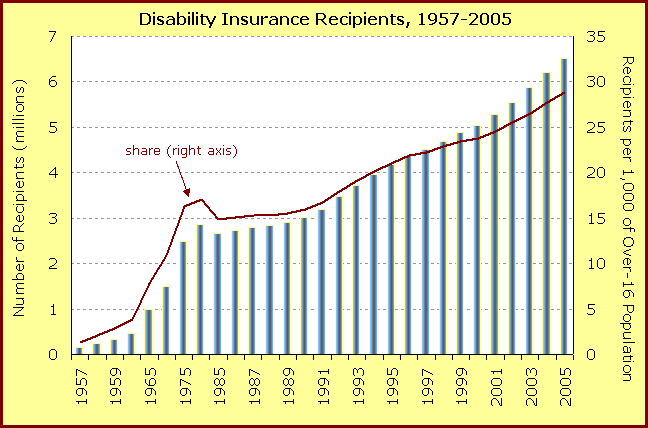What government insurance program has experienced the fastest enrollment increase since 1990?
The number of people receiving Social Security survivor benefits fell by 20 percent; the number receivng Social Security retirement benefits increased by 23 percent; and the number of Medicare recipients increased by over 25 percent. The number of Medicaid enrollees expanded by a whopping 63 percent. But these expansions are dwarfed by the 117 percent increase in the number of Americans receiving Social Security Disability Insurance (DI).
According to the Social Security Administration, DI benefits are to be awarded only to individuals that have provided medical evidence that prevents them from engaging in any “substantial gainful work.” The evidence can be for a physical or mental condition, and it must be expected to last at least one year or result in death. In addition, beneficiaries must be under age 65 and have worked at least five of the last ten years.
The chart below shows that in 2005, over 6.5 million Americans received DI benefits – a substantial increase over the 4.2 million in 1995, and 2.7 million in 1985.
What can explain such a dramatic increase?
- This trend is not a reflection of population growth. In 1985, fewer than 15 people received DI benefits per 1,000 in the over-16 population. By 2005, the share had risen to just under 30.
- This trend is not a reflection of an aging population. The American population has been aging, but not that fast.
- The trend does not reflect a rapid deterioration physical or mental health of Americans. Mortality rates for males and females aged 40-64 have been falling sharply. And a body of empirical evidence suggests that despite recent increases in measured obesity, there have been susbtantial improvements in a wide-range of health measures among those in an age group eligible to file for DI benefits. For example, the share of the population suffering from chronic disabilities fell from 26.2 to 19.7 percent from 1982 to 1999.
According to economists David Autor and Mark Duggan, the increase is largely attributable to three major changes to the DI program.
- Reforms to the DI program in 1984 led to a rapid increase in the share of recipients suffering from back-pain and mental illness (by allowing for applicants’ self-reporting of pain and discomfort, relaxing the strict screening of mental illness, and by allowing for many nonsevere impairments to qualify as disabilities).
- The DI program increased the amount of income that beneficiaries would receive relative to their former labor earnings.
- The rapid entry of females into the labor force after 1970 increased the pool of workers eligible to receive benefits.
The fiscal ramifications of the DI program expansion are serious. The Social Security trustees reported that in the most recent fiscal year, DI benefit payments exceeded $95 billion (equal to the spending of the entire Department of Transportation and the Department of Homeland Security combined). Autor and Duggan estimate that each new beneficiary is expected to receive lifetime benefits worth approximately a quarter-million dollars. And the existing DI program already accounts for nearly 20 percent of overall Social Security spending (up from 10 percent in 1985).
It appears that middle aged men are using the DI program as a form of early retirement, financed by the government dole. Even if the baby boom bubble has already passed through here (the oldest baby boomers are hitting 62 this year), the program is yet another example of unintended consequences gone wild, and it portends some of the difficult choices that will necessarily be made by the traditional social security program in the near future.
